a policy brief from ICPH
October 2012
It is no secret that a high school diploma provides lifelong social and fiscal benefits. Failure to complete high school or an equivalent is correlated with low lifetime earnings, few and low-paying employment prospects, and poor family-planning decisions, factors that can ultimately translate into a crippling cycle of poverty and dependence on public assistance.1 Nowhere are these outcomes more apparent than among homeless families, most of whom are headed by single females with young children.2 In 2011 over two-fifths, or more than 40%, of female-headed households lived below the federal poverty line.3 This report focuses on these families, looking at the strong link between family-planning decisions and receipt of a high school diploma or equivalent in a sample of homeless mothers living in New York City in 2011.
Sexual Initiation and Pregnancy
According to the Centers for Disease Control, the average age of sexual onset for young women nationally is 17.4 years.4 For homeless women, however, sexual initiation occurs nearly one year earlier, at age 16.5.5 When the data is controlled by educational attainment, a story emerges that speaks to the significance of a high school degree: of those women who did not complete high school (48%), 21% had had sex at or before age 14 and 66% at or before age 16, while only 12% of women who achieved a high school education or more were sexually active at age 14 or before and 53% at age 16 or before. (See Figure 1.) Though it is tempting to interpret the relationship between sexual decision making and educational attainment as causal, it may be more accurate to view both poor family planning and lack of schooling as outcomes of multiple interacting factors associated with poverty.
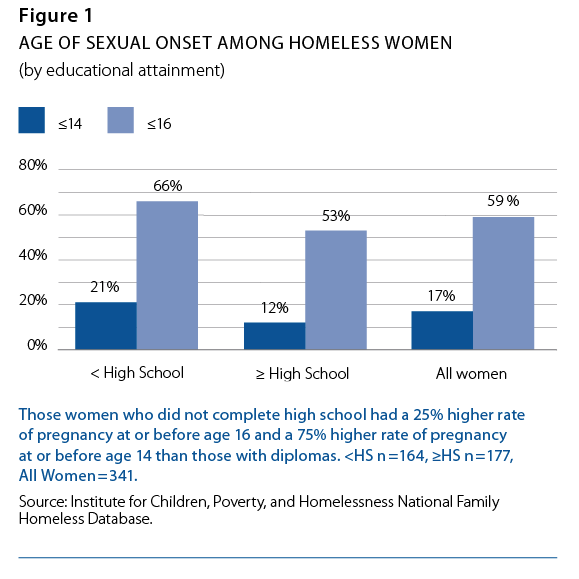
The early sexual initiation of homeless women is most troubling when viewed through the lens of birth control. Despite both groups’ reporting awareness of birth control (73%), understanding of where to obtain contraceptives (67%), knowledge of how to use them (65%), and the belief that birth control was important the first time they had sex (65%), only 39% of the total sample reported using contraception during their first sexual encounter. (See Figure 2.) Again, lower educational attainment was associated with lower awareness, less knowledge of where to find contraceptives, less understanding of how to use them, less belief in their importance, and failure to use them during first sex act. This pattern seems to imply that those women who feel the least invested in the education process and least focused on their future prospects also exhibit the least willingness to make arrangements to avoid unplanned pregnancy.
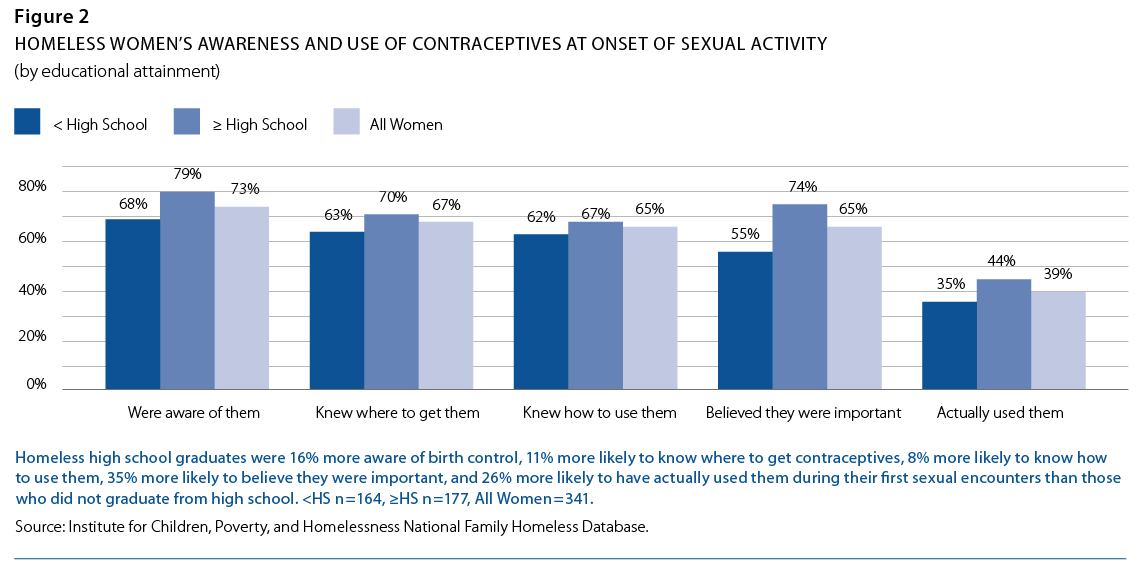
Most alarming is that attitudes and practices related to contraception at sexual onset seem to have changed little in 15 years. In 2011 the same proportion of homeless mothers (39%) reported having used birth control during their first sexual encounters as in a similar cohort of homeless mothers in 1996.6 Considering that the national downward trend in teen pregnancy is due primarily to increased use of contraception among teens—76% of those whose first sexual encounters occurred between 2000 and 2004 and 84% of those who first had sex between 2005 and 2008 reported using birth control at sexual onset—it is worrying that homeless women in 2011 were no more likely to have used birth control at first sex act than respondents of 15 years earlier.7 However, significantly more homeless women in 2011 (48%) reported regular use of contraception than in the 1996 cohort (35%). While encouraging, 48% is drastically lower than the statistic for the nation as a whole, which was 62% in 2008.8
Given their low levels of contraception use, it is not surprising that only 29% of homeless mothers had planned the birth of their first child and that 44% were pregnant by the age of 18. Children born to teenage mothers bring enormous costs to all levels of government. In 2008 teen childbearing cost the state of New York roughly $663 million and the nation $10.9 billion.9 Sixty-three percent of these mothers received some form of public assistance in the year following the births of their children.10 However, the majority of this fiscal footprint is related not directly to the mothers themselves but rather to the negative outcomes experienced by the children throughout their lives. These children require publicly funded health care, have higher levels of involvement in the child-welfare system, earn less as adults (which leads to lost tax revenue and lower spending), and have higher rates of incarceration.11 Furthermore, families with children born to teen parents are at greater risk of experiencing multiple episodes of homelessness (17%) than those with children born to adult parents (6%).12 (See Figure 3.) Worse still, girls born to teen mothers are more likely to follow in their mothers’ footsteps and become parents in their teenage years, thus continuing the cycle of poverty and dependence.13
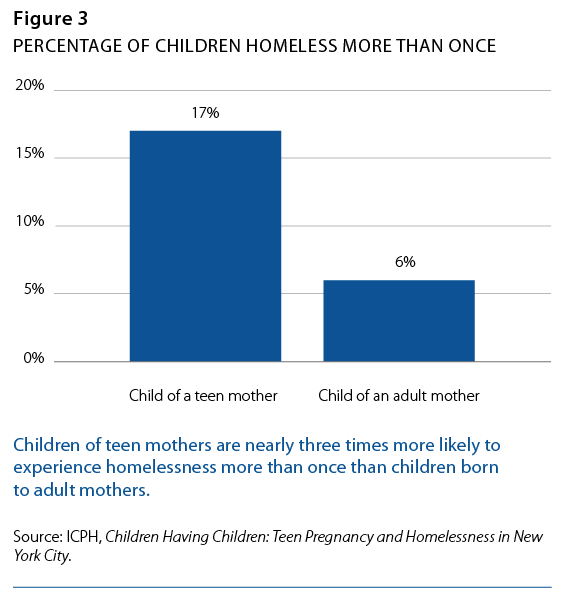
Greater educational attainment is associated with a more active role in reproductive choices. One in five (21%) homeless women who did not complete high school were pregnant with their first child at or before age 16, and more than half (53%) were pregnant at or before 18. (See Figure 4.) Those who completed high school or above became pregnant for the first time later—11% at or before age 16 and 36% at or before 18. Research suggests that young women are more likely to become pregnant after dropping out of high school, and completing high school with a baby in tow proves a goal many young mothers fail to reach.14 Young mothers without high school diplomas or GEDs will likely earn comparatively little money over their lifetimes, working few hours with low wages and increasing the probability of homelessness and reliance on public assistance. In fact, those women who fail to complete high school earn nearly 50% less over their lifetimes.15 (See Figure 5.)
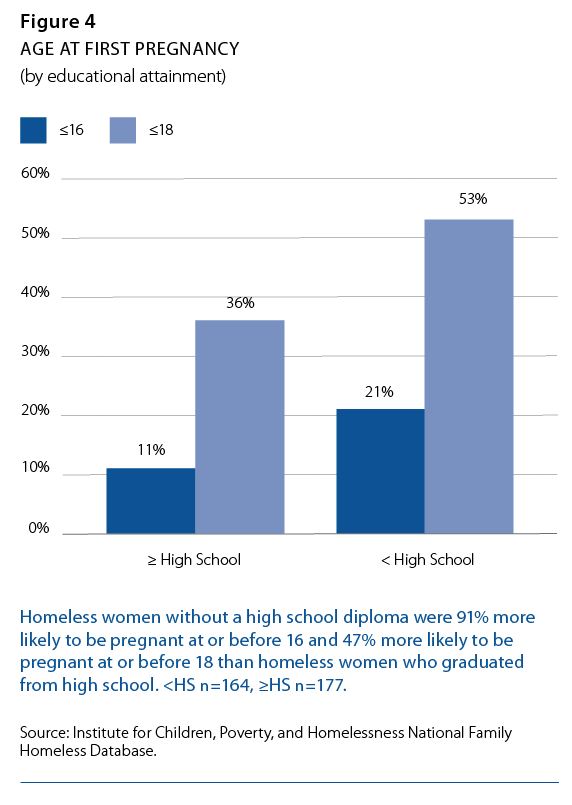
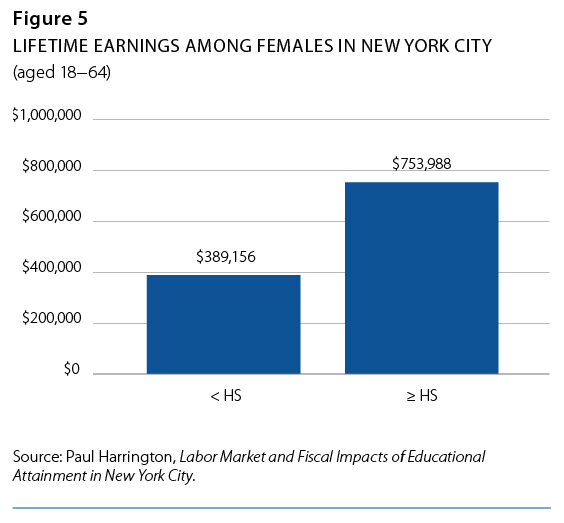
These associations reinforce the finding that those who have dropped out of high school are more likely to have a history of making family planning decisions that inadvertently undermine their ability to attain self-sufficiency. Even with a high school degree, it is difficult to find a job that pays a living wage. Not surprisingly, non–degree holders find themselves at the bottom of the skills totem pole, working in jobs that pay the lowest wages. It is no coincidence that the Bronx, the borough with the lowest rate of high school completion and the highest rate of teen pregnancy, has the highest level of family homelessness: an astonishing and consistent 37%.16 (More than 30% of Bronx female residents 25 or older have less than a high school diploma, as compared with 20% citywide.17 The rate of pregnancy there is 105.6 per 1,000 teens, versus 81.1 citywide.18 The national rate was 67.8 in 2008.19 See Figure 6.) With the median rent with utilities for a two-bedroom apartment in New York City at roughly $1,400 per month and minimum wage at $7.25 per hour, it is easy to see how mothers lacking diplomas or GEDs find themselves unable to obtain well-paid employment and ultimately end up in the homeless-shelter system.20
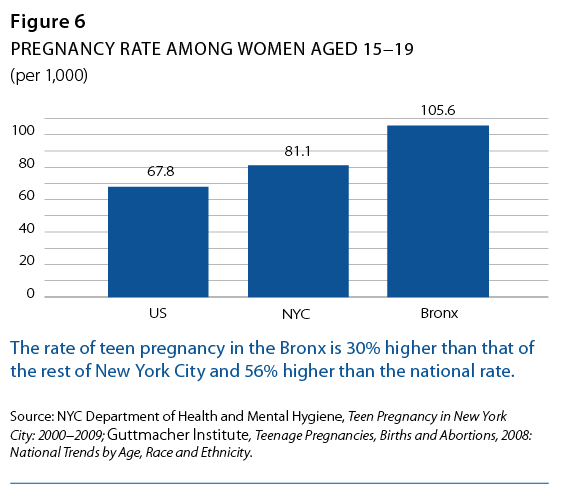
Abortions
Additionally, with so many women becoming sexually active and pregnant at such a young age, many of them undergo abortions. Of all homeless women, 28% had abortions at or before the age of 21. Yet, again, educational attainment mediated the relationship. Over one-third of women (34%) who did not complete high school first underwent abortions at or before 21, as opposed to 21% of women with high school diplomas. (See Figure 7.) This is consistent with the lower levels of contraception use and younger age of sexual initiation among non–degree holding homeless women, suggesting that young women with weaker ties to education obtain more abortions. Although one could argue that increased frequency of abortions results from teens’ feeling unready to have children, the high number of young women who deliver babies seems to undercut that suggestion.
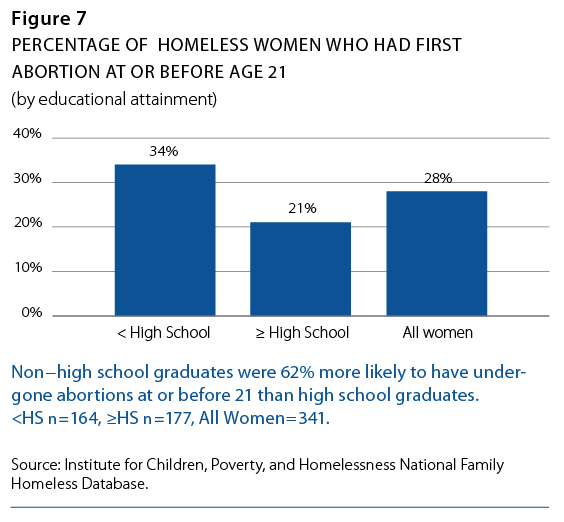
In this cohort, 38% of the women had undergone abortion at least once in their lives. Race played a factor in one’s likelihood of having had an abortion, with 44% of black, 30% of Hispanic, and 36% of white homeless women undergoing the procedure. In addition to race, education plays an interesting role. Black homeless women who did not complete high school were 26% more likely to have had abortions over their life course than those who attained degrees. Likewise, white women were 79% more likely to have undergone abortions if they were non−degree holders. Interestingly, Hispanic women with diplomas were 10% more likely to have had abortions. (See Figure 8.) Clearly, whether a homeless woman graduated high school has implications for behaviors throughout her life.
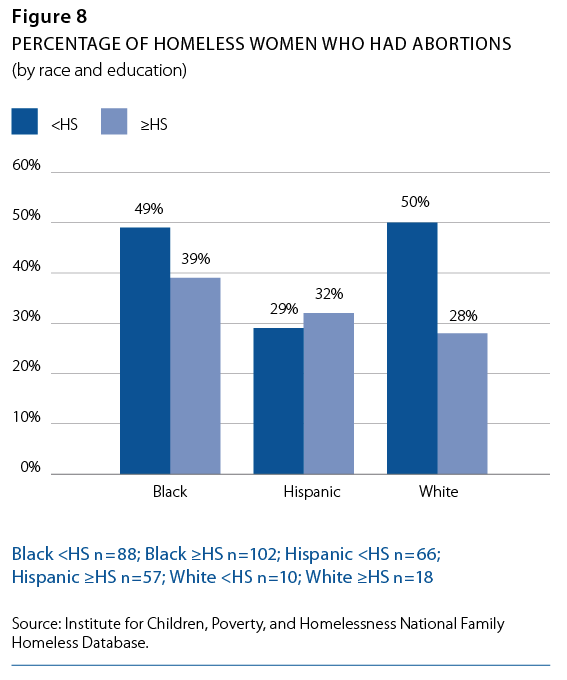
Conclusion
While the link between teen pregnancy and homelessness could easily be interpreted to imply that homeless women simply establish patterns of failure early on that persist throughout their childbearing years, another, more nuanced explanation for their lack of family planning could be insufficient self-efficacy when it comes to contraception. In a study of homeless women in Los Angeles, respondents reported many barriers to contraception use, including cost, side effects, poor knowledge of proper use and of where to buy contraceptives, and partners’ dislike. In this sample, 41% of women said that their partners’ dislike of contraception was a “small problem” or “big problem,” as opposed to “no problem,” when it came to birth control. Among those who reported this barrier as a “big problem,” 35% had not completed high school and 29% were aged 15–24.21
Greater investment must be made in training young women in the availability and proper use of contraceptives. The first steps have been taken with the advent of the new mandatory sex-education curriculum to be included in health education in New York City schools in sixth or seventh grade and ninth or tenth grade. It includes a focus on “developing the communication and interpersonal skills to avoid and/or handle high risk [sexual] situations.”22 Though this step may begin to address the crisis of confidence that can ultimately lead young women to poverty and homelessness, more must be done to ensure that poor women are not complicit in their own undoing.
Completing high school is a vital first step in countering the crippling effects of poverty. To this end, services that support young women in achieving a high school education are crucial. Helping teenage girls avoid pregnancy and assisting teen mothers in overcoming obstacles to their education are key measures in preventing homelessness. They need parenting skills, child care, and emotional support to help them stay in school and achieve financial independence. One program, New Heights, operates in 15 Washington, D.C., public and charter schools and has reached 553 pregnant and parenting students in 2012, helping them to stay in school. Funding for the program amounted to $1.959 million annually, with a per capita student cost of approximately $3,500 a year.23 This is a modest figure, considering that the average cost of raising a child is $235,000.24
Between school years 2010–11 and 2011–12, 64% of students involved in the New Heights program showed improvements in in-seat attendance, average daily attendance, and/or grade-point average.25 Not only do these programs increase the chances that teen parents will stay in school, graduate, and go on to college, but new research on the effects of poverty on children suggests that improving parenting skills, specifically maternal responsiveness to children’s needs, may offset some of the detrimental mental and behavioral outcomes associated with growing up in poverty and may be a key factor in the development of self-regulation—the ability to control one’s emotions and responses to situations or people.26 In other words, programs like New Heights carry benefits far beyond the attainment of a high school diploma: they help to train more capable parents who are more likely to raise well-adjusted children better positioned to attain self-sufficiency themselves. In 2004, the cost to society of a child born to a mother who was 19 or younger was an average of $1,430 more each year than of a child born to a mother who was just a year or two older.27 Given the high fiscal and social impact associated with teens’ dropping out of school and raising children of their own, investing in programs like New Heights is the most cost-efficient and logical way forward.
In tandem, we need to address the issue of teens who have already dropped out of school. Obtaining a GED increases earnings by an average of $115 per week, potentially making the difference between being able to afford an apartment and ending up in a city shelter. Why not take GED programs to people living in shelter? Given that 48% of homeless mothers did not complete high school and that the cost of a GED-preparation course is a mere $1,000,28 it is shortsighted to dismiss the utility and cost-saving potential of in-shelter GED courses. In fact, completing one’s GED should be a requirement for a New York City shelter stay.
This report has explored the interrelation of education, sex, and family-planning decisions among homeless women in the New York City shelter system. It makes apparent the dire fiscal and social consequences that poor women face when they do not complete high school and suggests ways to help teens stay on the road to self-sufficiency through cost-effective programs such as New Heights and training in sexual-negotiation skills. Making available services that help teenage mothers to stay in school or earn GEDs would augment lifetime earnings and protect more families from homelessness.